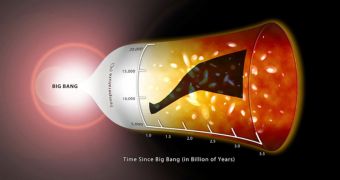Studies now show that the early Universe became sick when it was very young, when it sprung a fever as temperatures soared. The finding goes against all models of how the Cosmos evolved, which showed that temperatures dropped as time passed.
The largest temperatures existed in the Universe when the Big Bang took place, and the general consensus among astrophysicists was that temperatures continuously dropped after that.
But the new investigation reveals that a huge spike took place some 1.5 billion years after the beginning of cosmic inflation, and that the culprits were swarms of black holes that released a tremendous amount of energy in their surroundings.
The heating event took place between 12 and 10 billion years ago, and was due to the vast amount of ultraviolet (UV) radiation these black holes made spread throughout the Universe.
“One billion years after the Big Bang, the gas we measured was a 'cool' 8,000 degrees Celsius. By three and a half billion years, the temperature had climbed to at least 12,000 degrees Celsius [21,632 Fahrenheit],” says George Becker.
The expert, who holds an appointment at the University of Cambridge, was the lead author of the new investigation, which will be published in an upcoming issue of the esteemed journal Monthly Notices of the Royal Astronomical Society.
During the work, the expert and his team looked at how hot ancient hydrogen gas clouds were at that time. So many years ago, these clouds were a lot more dense, and occupied a significantly larger volume of space.
To get some perspective on this, consider that the hydrogen gas which disappeared from the clouds transformed into countless stars and galaxies.
The temperature of the clouds was assessed by analyzing light emitted by quasars, highly active galaxies powered up by supermassive black holes.
“The gas, which lies between us and the quasar, adds a series of imprints to the light from these extremely bright objects,” Becker explains.
“By analyzing how those imprints partly block the background light from the quasars, we can infer many of the properties of the absorbing gas, such as where it is, what it's made of and what its temperature is,” the expert says.
Universal temperatures were found to have spiked starting 1.5 billion years after the Big Bang. The discovery held true when the team looked at several quasars.
“The likely culprits in this intergalactic warming are the quasars themselves,” explains Cambridge University expert and study coauthor Martin Haehnelt, quoted by Space.

 14 DAY TRIAL //
14 DAY TRIAL //